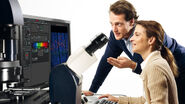What is a White Light Laser?
Supercontinuum White Light Lasers (WLL) convert monochromatic laser light into what is essentially a rainbow of spatially coherent light spanning a significant portion of the visible spectrum. From this “laser rainbow” you can select virtually any wavelength and intensity of light to excite your sample. Unlike traditional lasers, which are generally monochromatic or emit just a few discrete laser lines at once, a single WLL with AOBS can simultaneously deliver multiple excitation lines (up to 8). Our unique combination of high-efficiency pulsed WLL excitation, AOBS technology, and spectral detection system provides the architecture essential for achieving complete wavelength freedom. The ability of Leica Microsystems to combine these technologies with industry-leading detection technology brings a new standard in confocal imaging.

Pick a color, any color!
Vastly expand your multi-color confocal capabilities with WLL technology. Excite your sample with virtually any color imaginable within the visible range. The newest WLL configurations on board STELLARIS 5 and STELLARIS 8 extend the range of accessible fluorophores into the near infrared (NIR), with excitation wavelengths up to 790 nm, giving you more comprehensive spectral breadth. STELLARIS 8 also extends the range further into the blue spectrum, giving you a range from 440 nm up to 790 nm. Both STELLARIS 5 and STELLARIS 8 allow defined excitation wavelengths to be chosen from anywhere within the respective excitation range. The result is nothing short of revolutionary. No longer must your fluorophore choices be dictated by the limitations of your confocal system. Instead, STELLARIS adapts fully to your sample.

Up to 3 more colors without increasing experimental complexity
To give you more versatility in experimental design, STELLARIS has been optimized to produce a continuous spectral output well into the NIR range, up to 790 nm. This allows you to add up to 3 additional red channel without sacrificing a channel in the green spectrum, where GFP, FITC and other commonly used fluorescent probes are imaged. STELLARIS 8 takes this flexibility even further, with an extended WLL output ranging from 440 nm to 790 nm. This means you can take full advantage of blue-excitable dyes. The STELLARIS 8 laser is unique in the confocal market and comes as a complete package with a choice of detectors from our expanded Power HyD family.

Add trailblazing new confocal applications to your repertoire
The extended range of excitation wavelengths available on board STELLARIS 8 system gives you access to novel fluorophores, opening up countless new application possibilities. Notably, the blue extension allows you to take advantage of fluorescent proteins such as ECFP, Cerulean and mTurquoise2, which are increasingly being utilized in innovative FRET-based biosensors.
At the red end of the spectrum, the ability to excite red-shifted fluorophores such as the near-infrared fluorescent protein iRFP720 gives you even more experimental options . For live-cell imaging, red-shifted probes are often the first choice to avoid phototoxic effects induced by shorter wavelengths. Red light also penetrates deeper into thick samples, making red-excited fluorophores especially attractive for 3D imaging of tissue and ex vivo samples such as biopsies. To make the most of the red extension on the WLL, our specialist Power HyD R detector maximizes efficiency for increased sensitivity and premium quality images.

Step into a new dimension of lifetime applications with TauSense
A key advantage of pulsed WLL technology is that it enables time-gated measurements, which are fundamental for the time-resolved imaging behind TauSense, the powerful new set of lifetime-based imaging tools at the core of STELLARIS. Fluorescence lifetime-based information delivered by TauSense adds a powerful new dimension to your research, enabling you to reduce unwanted fluorescence background, to increase the number of fluorescent probes you can resolve in a single sample, and to perform metabolic studies with the appropriate biosensors. In addition, our unique combination of pulsed WLL excitation, field-programmable gate array (FPGA) electronics and fast, spectral, single-photon counting Power HyD X and Power HyD R detectors underpins the innovative FAst Lifetime CONtrast (FALCON) module, which enables video-rate fluorescence lifetime imaging for rapid kinetic studies in live cells and additional in-depth FLIM studies.







